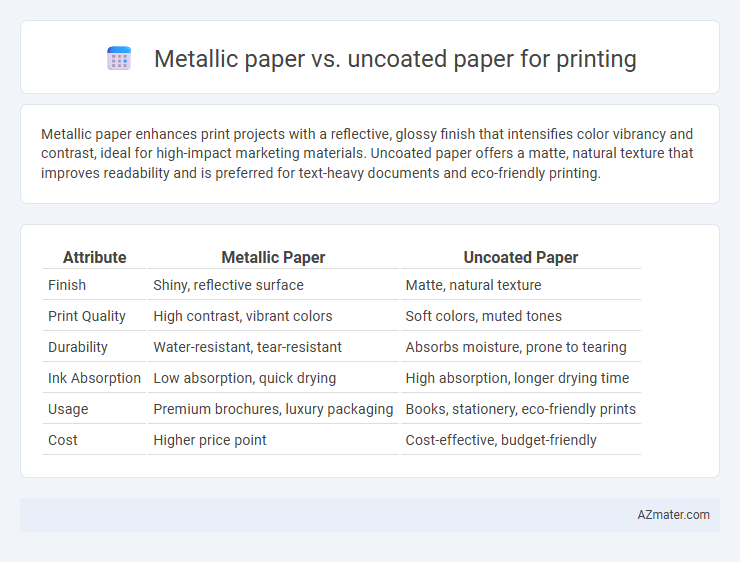Metallic paper enhances print projects with a reflective, glossy finish that intensifies color vibrancy and contrast, ideal for high-impact marketing materials. Uncoated paper offers a matte, natural texture that improves readability and is preferred for text-heavy documents and eco-friendly printing.
Table of Comparison
| Attribute | Metallic Paper | Uncoated Paper |
|---|---|---|
| Finish | Shiny, reflective surface | Matte, natural texture |
| Print Quality | High contrast, vibrant colors | Soft colors, muted tones |
| Durability | Water-resistant, tear-resistant | Absorbs moisture, prone to tearing |
| Ink Absorption | Low absorption, quick drying | High absorption, longer drying time |
| Usage | Premium brochures, luxury packaging | Books, stationery, eco-friendly prints |
| Cost | Higher price point | Cost-effective, budget-friendly |
Overview of Metallic Paper and Uncoated Paper
Metallic paper features a shiny, reflective surface that enhances color vibrancy and adds a luxurious finish to printed materials, often used for high-end brochures, packaging, and promotional items. Uncoated paper has a natural feel with a matte finish, offering excellent ink absorption and a less glossy appearance, making it ideal for books, letterheads, and everyday printing needs. The choice between metallic and uncoated paper depends on the desired visual impact and tactile experience for the printed product.
Key Differences in Appearance and Finish
Metallic paper features a glossy, reflective finish that enhances colors with a shimmering effect, making images appear more vibrant and dynamic, while uncoated paper offers a matte, natural texture that absorbs ink for a softer, more muted appearance. Metallic paper tends to highlight details and depth in printed photos or designs due to its smooth surface, whereas uncoated paper provides a tactile, organic feel that is ideal for text-heavy prints or a vintage look. The choice between the two significantly impacts the visual appeal and texture, with metallic paper emphasizing shine and brightness and uncoated paper favoring subtlety and readability.
Print Quality: Metallic vs Uncoated Surfaces
Metallic paper enhances print quality by offering vibrant, reflective colors and a glossy finish that makes images and text stand out, especially in high-end marketing materials. Uncoated paper provides a natural, matte surface that produces softer, more muted colors, suitable for a classic, understated look. The smoothness and light absorption of metallic paper result in sharper details and a premium appearance, whereas uncoated paper excels in readability and a tactile, organic feel.
Color Vibrancy and Image Sharpness Comparison
Metallic paper enhances color vibrancy by reflecting light through its shiny, glossy surface, making hues appear more saturated and vivid compared to uncoated paper. Image sharpness on metallic paper benefits from its smooth finish, which allows ink to rest on the surface, resulting in crisper edges and finer detail reproduction. In contrast, uncoated paper absorbs ink more deeply, leading to a softer appearance with less intense colors and reduced image sharpness.
Paper Durability and Handling
Metallic paper features a coated surface that enhances durability by resisting moisture, scratches, and fading, making it ideal for long-lasting prints and high-handling applications. Uncoated paper lacks this protective layer, resulting in lower resistance to wear and tear but offers a natural texture favored for easy writing and superior ink absorption. For projects requiring robust handling and archival quality, metallic paper provides a more resilient choice, while uncoated paper suits casual use or eco-friendly printing needs.
Cost Considerations in Printing Choices
Metallic paper typically incurs higher costs due to specialized coatings and reflective finishes that enhance image vibrancy and appeal, making it ideal for premium print projects. Uncoated paper offers a more budget-friendly option, as it requires less processing and delivers a natural, matte finish suitable for everyday printing needs. Evaluating project requirements against these cost disparities helps optimize printing budgets while maintaining desired quality levels.
Best Applications for Metallic Paper
Metallic paper excels in printing high-impact marketing materials such as business cards, luxury brochures, and invitation cards due to its reflective sheen and premium finish that enhances color vibrancy. It is ideal for designs requiring a sophisticated, eye-catching look, especially in branding, packaging, and promotional prints where visual appeal influences consumer perception. Unlike uncoated paper, metallic paper provides superior durability and resists smudging, making it a preferred choice for long-lasting, upscale printed products.
Ideal Uses for Uncoated Paper
Uncoated paper is ideal for printing projects that require a natural, tactile feel and excellent ink absorption, such as business stationery, letterheads, and brochures. Its porous surface enhances readability and is preferred for materials needing clear, smudge-free text and vibrant colors with a matte finish. Additionally, uncoated paper is environmentally friendly and often used for printing eco-conscious marketing materials and books.
Environmental Impact and Sustainability
Metallic paper often involves synthetic coatings and foils that hinder biodegradability and complicate recycling processes, resulting in a higher environmental footprint compared to uncoated paper. Uncoated paper, derived from natural fibers and free of heavy chemical treatments, generally offers better biodegradability and recyclability, making it a more sustainable choice for printing. Choosing uncoated paper supports reduced waste and lower carbon emissions in the paper production lifecycle, aligning with eco-friendly printing goals.
How to Choose the Right Paper for Your Project
Selecting the right paper for your printing project hinges on its purpose and desired visual impact; metallic paper offers a glossy, reflective finish ideal for luxury branding and enhancing color vibrancy, while uncoated paper provides a natural, matte surface that works well for readability and a more tactile, organic feel. Consider the durability and finish requirements, as metallic paper is less suitable for writing but excels in promotional materials, whereas uncoated paper supports better ink absorption and is favored for books, stationery, and eco-friendly projects. Evaluate project goals, budget constraints, and paper compatibility with your printer to ensure optimal print quality and effectiveness.

Infographic: Metallic paper vs Uncoated paper for Printing
 azmater.com
azmater.com